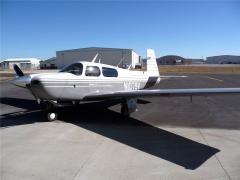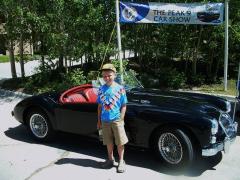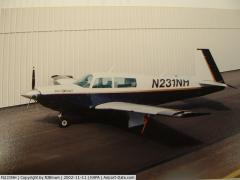-
Posts
1,004 -
Joined
-
Last visited
-
Days Won
4
Content Type
Profiles
Forums
Blogs
Gallery
Downloads
Events
Store
Everything posted by RJBrown
-
-
From the album: RJBrown
-

My son and another toy a 1962 MGA 1600 MK11
RJBrown posted a gallery image in Old MooneySpace.com Images
From the album: RJBrown
-
From the album: RJBrown
-
I dont think it was stall speed. The same airframe stalls at 61kts as a Rocket at 3200lbs. 69kts@ 2900lbs for the 252.
-
There is no way (for the plane) to detect if only one brake is deployed. Part of the certification process was to show that if only one were deployed that the plane remained controllable. If you turn off the master switch before the brakes are retracted they "slam" down. I had one that would stick, I sent it in for repair. Easy to install and remove. They are more effective the faster you go. At high speed with only one deployed there is a mild yawing moment. In the pattern with only one up you can barely notice it.
-

Corrosion inspection during pre-buy?
RJBrown replied to FlyingAggie's topic in Modern Mooney Discussion
Corrosion never sleeps. Even if it was checked you need to know it is OK today. There is no remediation, no permanent fix. The SB replaces (Correct me if I am wrong) insulation that held moisture with insulation that doesn't. This helps fight future corrosion but wont stop it. One reason both my planes were always based here in Colorado. -
Don't tell my MSE but I still miss my old Rocket, except in the wallet.
-

M20L (Porsche) IO-550 conversion information
RJBrown replied to NewHeights's topic in Modern Mooney Discussion
The last couple of posts both refer to the Missile. The Missile / Ovation comparison deserves some comment. The Missile is based on the shorter J airframe and as such generally has a lower empty weight. The gross weight of 3200 lbs on the lighter airframe leaves more useful load (about 1100) than the Ovations 3368 gross. To get the higher gross weight Mooney had to beef up the landing gear, an example of weight begets weight. Both use the same engine and the same flying surfaces. The Missile always out performs the Ovation because of weight. When the Rocket and Missile were engineered they were designed with an engine mounting system that ties into the fuselage at 8 points. This gives them a distinct strength advantage over the Mooney factory models that continue to use only 4. -

M20L (Porsche) IO-550 conversion information
RJBrown replied to NewHeights's topic in Modern Mooney Discussion
Years ago I had a bad experience with MOD WORKS. I had hail damage on my Rocket. At the same time I chose to add an Intercom, a EDM700, longrange tanks, speedbrakes, fuel tank repair, an annual, IFR cert, a TLS light in the left wing and a complete paint. After a lot of what I thought was careful research I chose Mod Works. Quite a bit of work to have done at once on one plane. The job was promised in 2 months. 4 months later it was finally "done" What they did they did fine. BUT part of the hail repair was to include wing panel replacement. The insurance company approved panel replacement and that is what I approved and expected. They bondoed up the hail dents AND charged for panel replacement. No wonder they are out of business. Some of the same people are now with Mooney Mart. After Mod works was gone I called Mooney Mart and the same guy that ripped me off answered the phone. I think both companies came from one. -
There is a valid reason for the extra cost of aviation carpet. When you install carpet in your airplane you MUST note it in your logbook. The Airtex people include the form you need. It identifies the carpet as meeting the proper (fire resistant) specification. I think Airtex still sells approved carpet by the yard. If you buy carpet by the yard from Home Depot, or the like, without the certification you are responsible to have an approved lab test and certify your carpet. As you can see to be legal it is cheaper to use an approved source than to make your own. If you use unapproved carpet or fail to properly log the change there is the possibility of voiding your insurance by operating the aircraft outside of it's type certificate. The carpet must be both fire retardant and when it burns, I believe. it must Not put off toxic smoke. I used an Airtex kit in a 231 and it looked great and fit perfectly. When reupholstering seats you can use leather as it naturally is safe. If you use fabric I believe it to must be "approved".
-
This was one of the overpriced planes that was on the market over a year ago. Proof that it was overpriced? It is still for sale. Some of these planes are listed just so the husband can tell the wife, I am trying to sell it. Serious sellers SELL.
-

Lycoming Echelon M20E/F/J engine upgrade
RJBrown replied to Grant's topic in Modern Mooney Discussion
I have seen the press release and it sounds compelling. I am at about 1800 hrs on my MSE engine. I am interested is knowing how much of a cost premium it wiil be to go with the 390. The solid "how much" has been hidden fairly well by Lycoming. -
-
When I flew 231NH as a stock 231 heat was the limiting factor for operations at any altitude. The oil temperature was the first sign. The oil temp gauge was an important part of my scan, it was where the first indications of over temp showed up. Any thing to reduce temp on a 231 is a plus. The Merlyn allows full power to a greater altitude. The fixed wastegate limited the turbo at higher altitudes. With the higher power at altitude I would want an intercooler. After the engine went on my 231 it was converted to a Rocket. The Rocket has two intercoolers. Heat was never a problem again. Though I have never operated a 231 with just a Merlyn I would want both it and an intercooler if I were to buy one. The higher you fly the less effective the cooling is. Though the air is cooler at altitude it also has less mass and conducts heat away from the engine less effectively. I consider both the Merlyn and the intercooler required components on a 231 and would deduct the cost of adding them from the sales price of one. I had stopped to post at this point but then read the next post. Here is my reply to it. I preface my next remarks. Please dont be offended ILXLR8. You opinions ARE from your Porsche experiance. That experiance does not apply directly to the 231. I believe the Porsche\ Mooney argument is Apples/Oranges. It totally misses the point. OVERHEATING is the issue NOT go fast. There never was a overheating issue with the Porsche. The Enemy of any aircraft engine is heat. That goes triple for a turbo at high altitude. Anything that pulls heat out of an engine at altitude helps. My MSE makes less than 100HP at altitude. My Rocket made 305HP at 24,000'. The cooling needs are night and day "My 231 has the factory wastegate and is without an intercooler. I believe the only main negative to the factory wastegate would be in the event of a go-around. If you abort a landing, you can NOT add full throttle. If you do, you will overboost. You must advance the throttle up to 39LB. This obviously adds another item to your workload while you are reconfiguring the plane. Good training will keep you from overboosting!" The advantage of the Merlyn is both no overboost at sealevel and more power at altitude. The original wastegate is fixed not variable. It HAS to be set to overboost at sealevel otherwise it would begin to lose power from sealevel just like a non turbo. The fixed wastegate then limits boost and causes the 231 to start losing MP at a lower altitude. The Rocket is able to maintain 100% power up to 24,000' BECAUSE it has a variable wastegate. Adding a Merlyn to a 231 increases it's critical altitude. "On the 231 the redline is 40LB and I believe the factory wastegate opens at 42LB. What I keep wondering is, why did the factory install wastegates that dump extra pressure at 42? Something tells me that if the factory wastegate opened at 40, it would become impossible to overboost. Maybe this was done to get higher HP numbers?" The wastegate is NOT the type that opens to limit boost, it is preset, Fixed in one place. The popoff valve opens at 42" and dumps pressure. The wastegate does not open and limit boost. Because the wastgate is "fixed" it then creates a lower critical altitude. Mooney did it to save money. It was a BIG mistake.
-
It has been over 7 years since my last trip to South Padre. We flew into BRO. We enjoyed the CAF museum there. We are looking at spending a week there for spring break this March. The big difference seems to be car rental. Since BRO is where the airlines are the cars are cheaper,check CarRental.com. Any recent pirep on the FBOs there. Air nav and 100ll show prices pretty close between the airports.
-

Bravo for sale, cheap - not mine - just found it
RJBrown replied to blacknchrome's topic in Modern Mooney Discussion
I don't mean to bad mouth the plane, I would have bought it for the right price. It just was quite a disapointment seeing it for the first time. The plane looked sad and neglected. For the right price and a bit of love it could be someones pride and joy again. It is a solid plane afterall. A year later I bet they wish they had sold for 135 it instead of acting offended. -

Bravo for sale, cheap - not mine - just found it
RJBrown replied to blacknchrome's topic in Modern Mooney Discussion
-

Bravo for sale, cheap - not mine - just found it
RJBrown replied to blacknchrome's topic in Modern Mooney Discussion
I had a contract to buy this plane a year ago Christmas. I chose to do the Pre buy at the MSC in Denton. I guess they later did the annual there in Denton. I am sure US Aircraft has records of my prebuy. They were great to deal with and could give straight answers about what was done for the annual. The plane was far from airworthy at that time. They refused to get it airworthy and they backed out of the sale, I still would have bought it. The original N Number was N808MS. It had been owned by a lawyer in California for a long time and had just sat outside for years getting nothing but paper annuals. It appeared to be a solid plane just a bit neglected. I see they replaced the pilots side interior panel since I saw it. Paint looks better in the pictures than in person. The story at the time was "Divorce forces sale" Engine Overhaul was A long time ago. Garmin install was done by this owner and the antennae poked through the headliner. The fact that the avionics shop didn't have the forethought to center the antennae made me question their professionalism . I have pictures on my laptop at home if any want to see I will post tonight. -
The Hartzell 3 blade is sexy to look at but slows the plane. Mooney actually increased the speed of the Ovation when they went back to a two blade from the 3. A 3 blade is generally smoother, if not it may need balanced. They also accelerate better.
-
Quote: Buster1 In looking at 231s, I've never really considered any Mooney Rockets. I read somewhere that the fuel burn, OH costs, and weight of the oversized motor were all problems. So I dismissed the Rocket. What are your thoughts? Is this a 'good' plane. Is this a better way to avoid the problematic TSIO-360 GB/LB found in a "standard" K? What are the considerations for a Rocket?
-
Quote: Mitch There is apparently an issue with weight being added in the tail section. According to a Mooney representative, the only break up of a Mooney was a Rocket. The tail feathers were found approx. 1 -2 miles prior to the actual crash sight.
-
A couple of you ask about where my picture was taken. Here is a little report about the Gateway Canyon Resort and Auto Museum. Last Sept I flew into the forest service strip next to the resort with my wife and son. This is a fun little place in the middle of nowhere. The founder of the Discovery Channel fell in love with the location and built a resort and museum to house his car collection. The most notable car in the collection is the Oldsmobile F-88 concept car that he bought at auction for $3,200,000.00. Call ahead and they will send a jeep up to pick you up at the airstrip. There is an adventure center where you can scedule activities. We chose to go ATV riding. We saw the uranium mine and stopped to view the valley from the rim. We went all the way into Utah and around back. Other activities include fly fishing, bike riding, Jeep tours and Horseback riding. A lot or people make the trip over by motorcycle. http://www.gatewaycanyons.com/ has resort information.
-

Wing mounted landing/taxi lights on earlier J.
RJBrown replied to PTK's topic in General Mooney Talk
Did not remove from nose just added to the left wing only. At 2500 per wing its not cheap but well worth it. I was constantly replacing the bulbs in the nose. Had the bulb filaments break on final and landed dark more than once. Never burned out a wing bulb in 5 years. Had it done when the Rocket was painted 10+ years ago. Paper work was part of the job. -
Quote: JimR In Nov of 1994 I was in the market for my first airplane. I found a local 231 with 1170 hours on it. After it passed the prebuy at the local MSC I bought it. During the next 7 months I flew it all over the west. Visiting San Marcos TX, Catalina Island CA, Jackson Hole WYO, Phoenix AZ, Seattle WA and Salt Lake UT. As I put those 100 hour on it the oil consumption slowly rose. The MSC assured me that the engine was OK And sold me a M-20 oil air separator. On my trip up to Spokane WA to visit my cousin It used a little over 2 quarts in 4 hours. Topped the oil and took off for Denver. Once over the mountains of North Western Idaho I noticed oil temps rising and pressure dropping. I made a precautionary landing in Orofino ID.There was less than 3 quarts in the engine after only 8/10th of an hour. A man in a pickup heard my radio calls and met me at the airport. We pulled the cowl fill the oil and did a run up. I expected to find that the vacuum pump installed that morning was the source of the oil loss. No leaks, the oil was blowing out the exhaust. At that point I re cowled the engine and flew first to Lewiston then Moscow then Spokane checking and adding oil at each stop. Long story short 6 months later I owned a 305 Rocket. In subsequent investigation I learned that 1200-1300 hours is the decision point for most 231 pilots. Checking logs and for sale ads it became apparent that most 231s either got a OH or at top and a turbo around that time. V-REF considers the 231 engine a 1530 hour engine and I consider them generous. Unless it has had a resent top and turbo I consider any 231 runout at 1300 hours. Any 231 should already have the Merlyn and an inter cooler and the lack thereof I consider poor maintenance. I was burned by believing in the 1800 hour TBO. It is not like a Lycoming IO-360 where most make it to 2000 or beyond without major work. As a Rocket the K is an amazing airplane, a true 4 passenger airplane. It will lift almost anything you can close the door on up to the flight levels at over 1000 FMP. It will then cruise at 200 Knots at 12,000' and faster higher. At light weights I have seen 1500 FPM at 26,000'. All that performance comes at a price. 35+ GPH in the climb and 20+ in cruise. Handled properly most Rockets surpass the 1600 Hour TBO and many pass 1800. They are more like the 252 in this respect. The TSIO-520NB has a proven track record in Cessna twins and the Rocket. After operating it as a Rocket for over 700 hour I sold it in March of 2003. Broke my heart to look back at her on the ramp in Vegas as I walked away. I chose to sell her for a land deal and I missed not flying for almost 6 years. With the sale of a warehouse in the fall of 1998 I held out enough to buy another airplane. I found myself in the market, expecting to buy another 231. I looked at Rockets and even had a contract and a prebuy on a TLS. I decided that I did not need the expense they require as I head into retirement. I will retire in 5-8 years and this plane will be my retirement toy. I looked at all the 231s out there and barley missed buying on a couple of reasonably priced ones. Most of the others either had problems or their owners had not heard we were in a recession and were asking way over market. 2 years later some are still for sale. A local Broker had a 79 231 for sale so I went to look at it. Unfortunately it still had 79 radios and the brand new paint was just plain ugly. This broker also had a 1650 hour 1990 MSE for sale. He talked me into taking a look. Now I was in the 210 vs 231 debate for myself and for real. After weighing all the pros and cons I surprised my self and bought the J model. What it came down to was costs and climb. The fixed costs of both planes are about the same. The operating costs for a 231 are about 1 1/2 times that of the 201. Fuel, maintenance and repairs are all about half again more for the 231. Engine reserve costs are even higher. According to V-REF the 201 reserve cost is $12.00 per hour while the 231 is $22.00 per hour. A 201 operates up to about 16000' while the 231 can climb to it's service ceiling of 24000' faster than the 201 can make 16000. The costs are 1 1/2 half times as high and so is the climb for a 231. If you are willing and able to pay the additional costs the 231 is a wonderful airplane. For me I made the practical decision to buy the MSE. That is if any decision to buy an airplane is practical. As I fly west of Denver where 15 miles from my home the MEAs start at 15500 there are times where I wish I had made the other choice. Though as I cruise on 8 GPH behind a much more durable engine I feel reassured that I made the right decision FOR ME. There are still times that I cheat on my bird and look at those for sale. In fact there is a pretty 1980 231 up in Wyoming for sale on trade a plane right now. It has under 20 hours on a new prop and a factory engine, it even has a Garmin. If It had been available a year ago I might be writing this from the other side. Both airplanes are GREAT. The step up from a Piper to a 201 is more than onto the 231. You will be happy with either plane. Both the 201 and the 231 are the fastest and most efficient plane in their class. Good luck and blue skies Randy
























